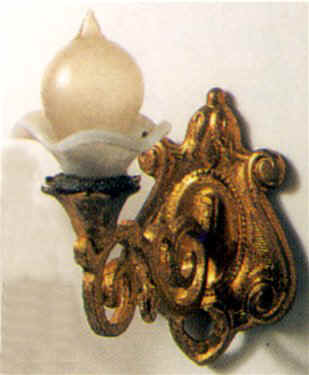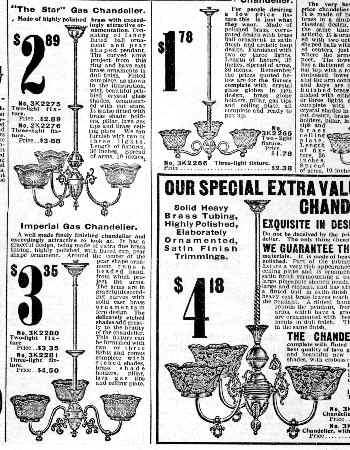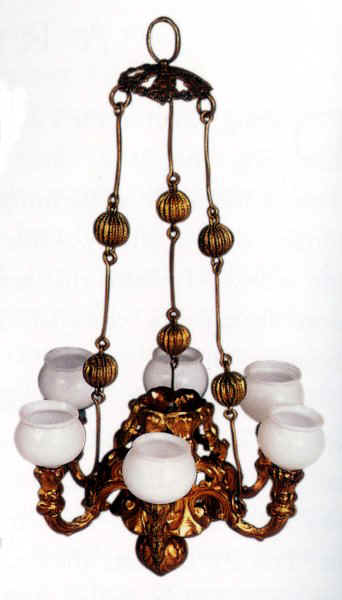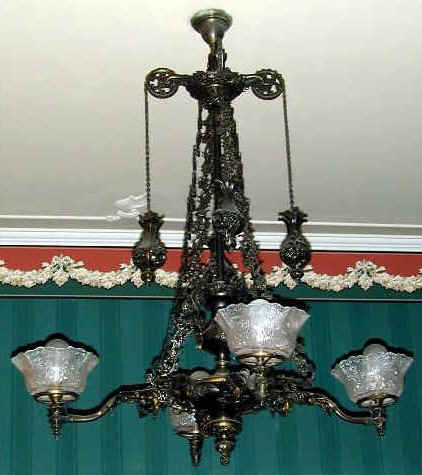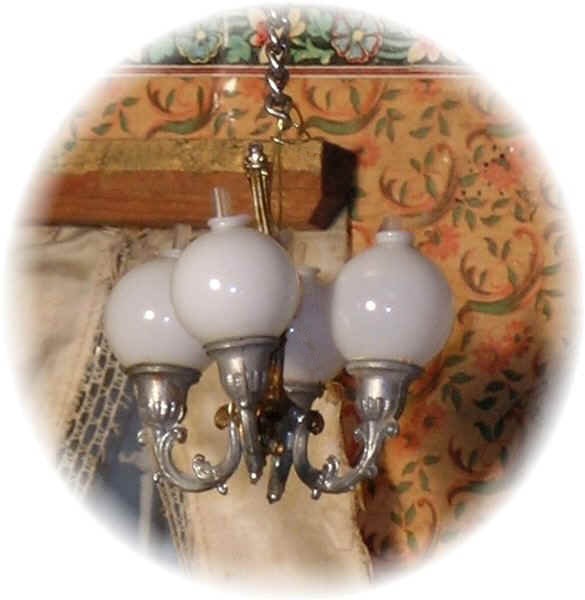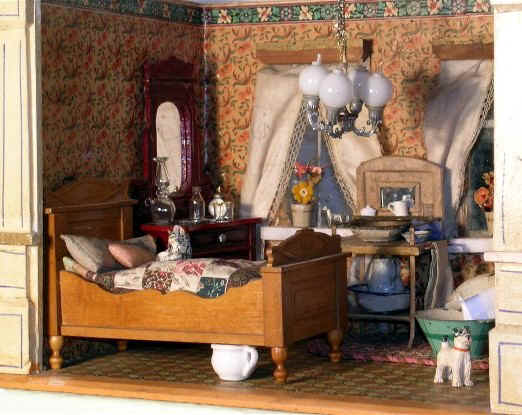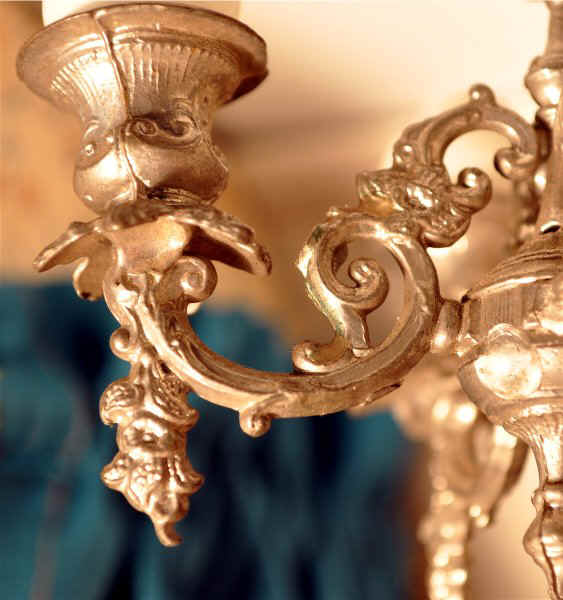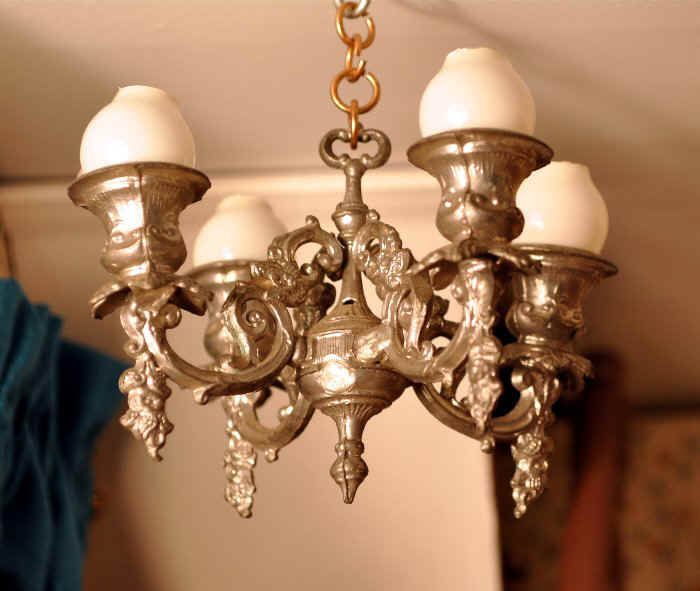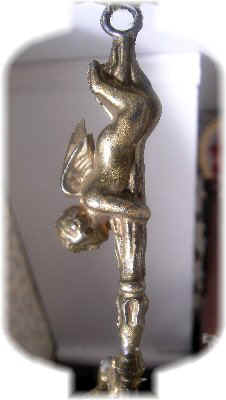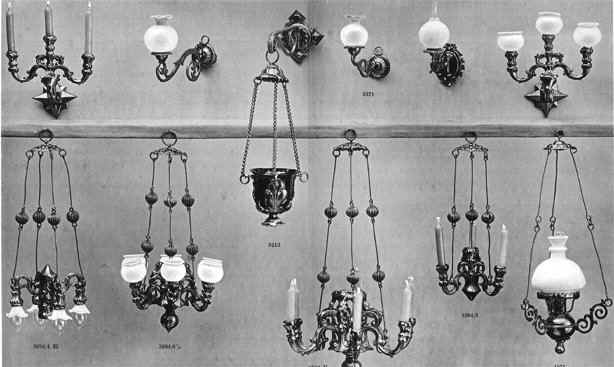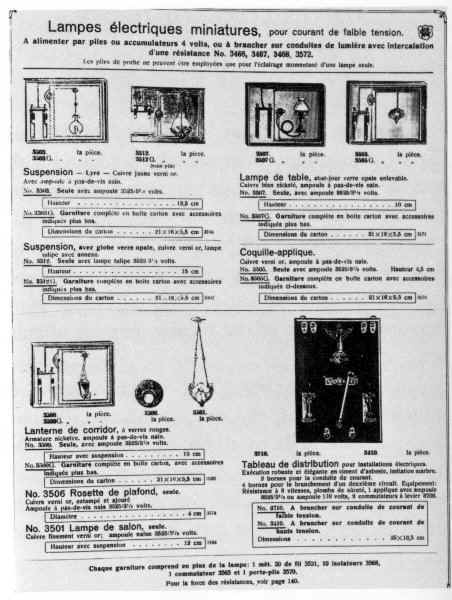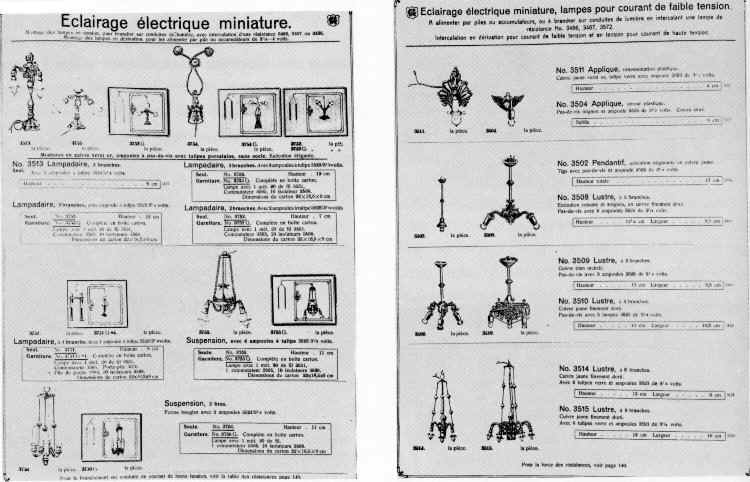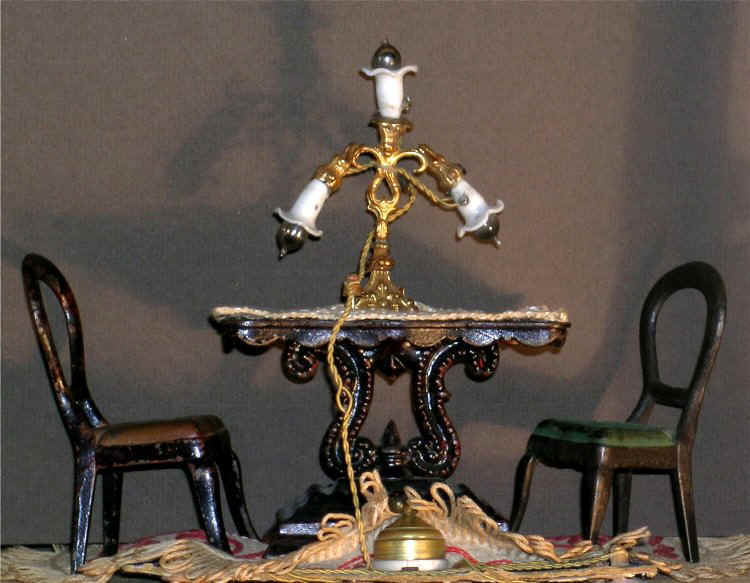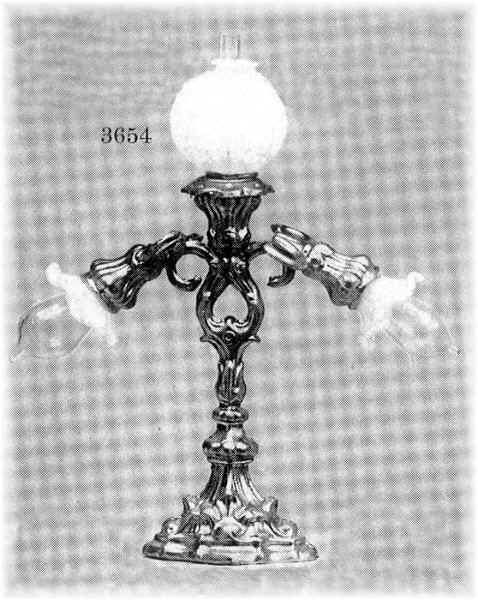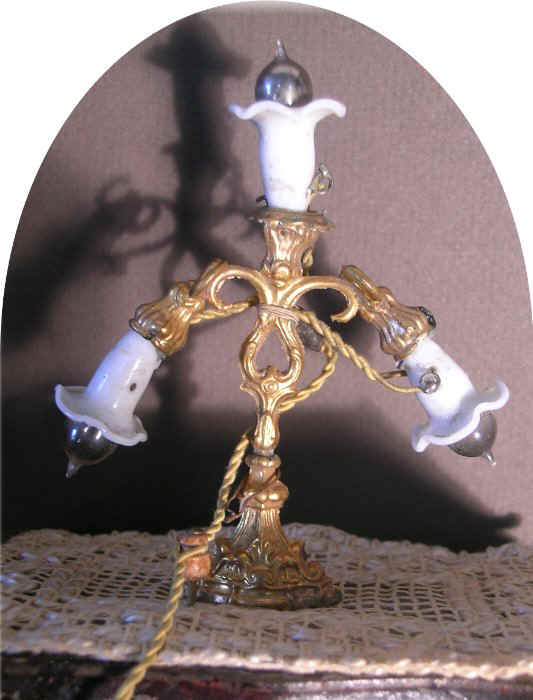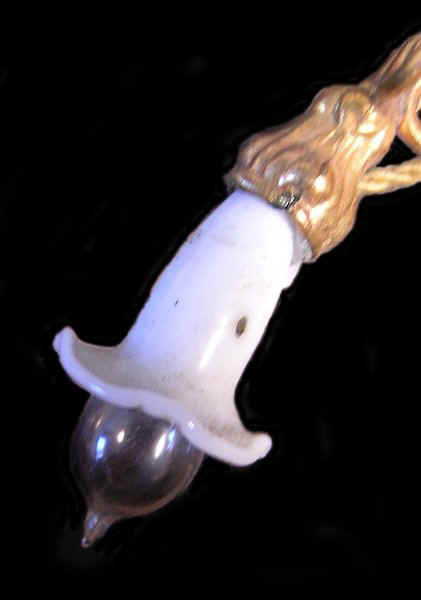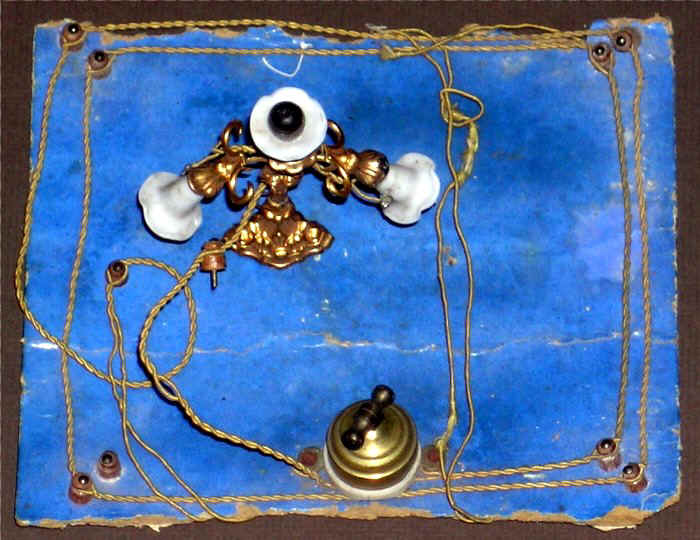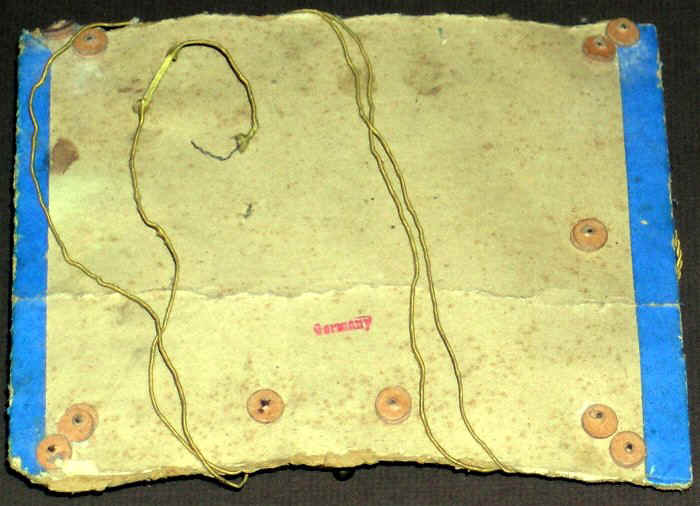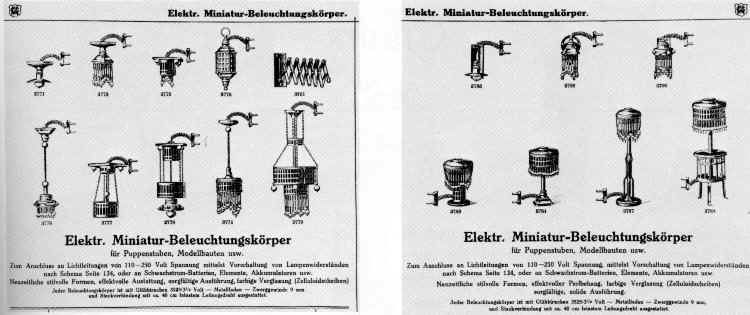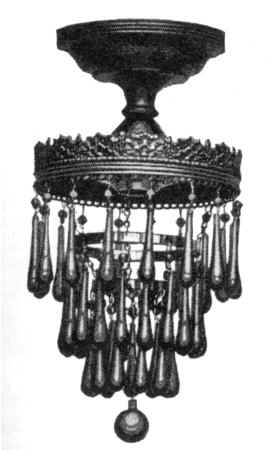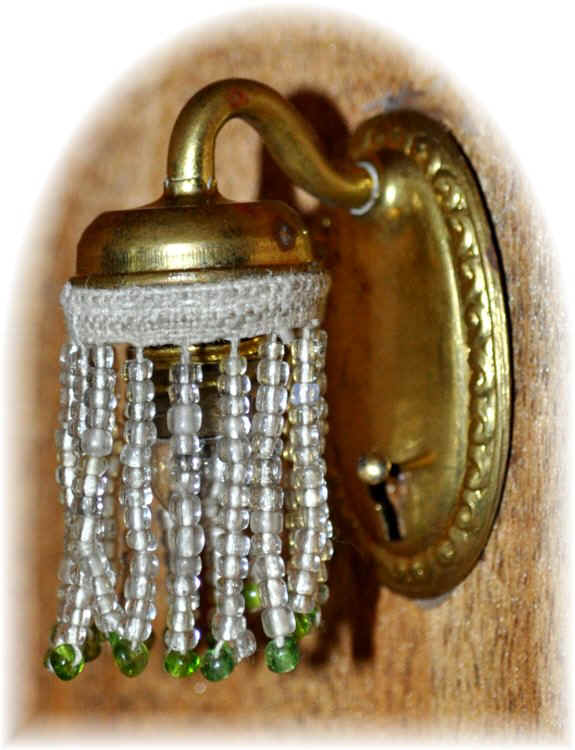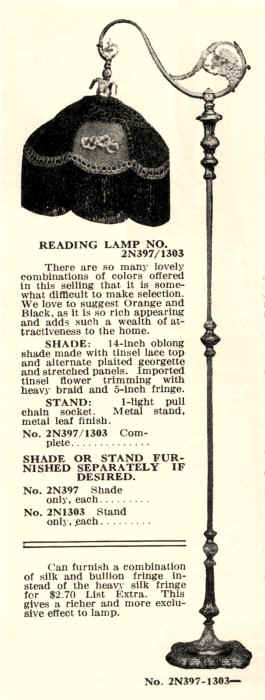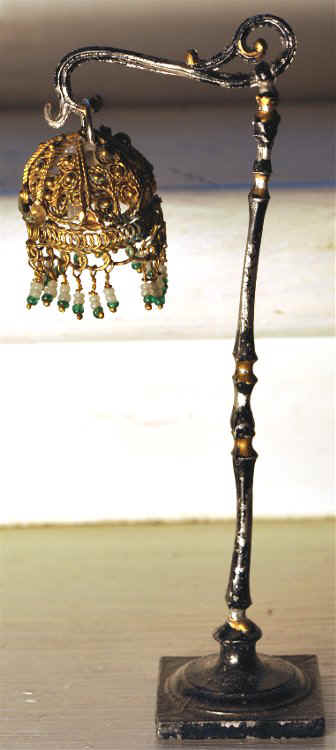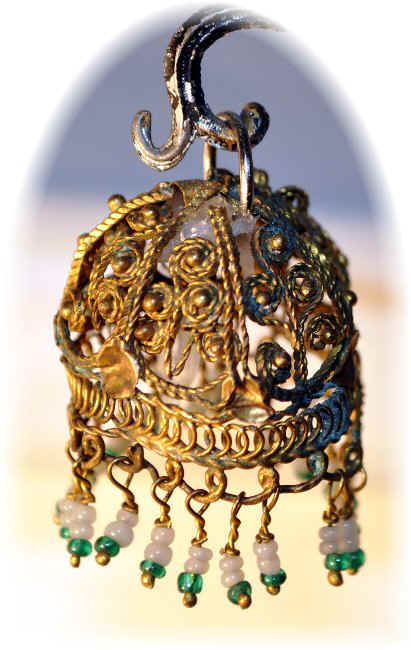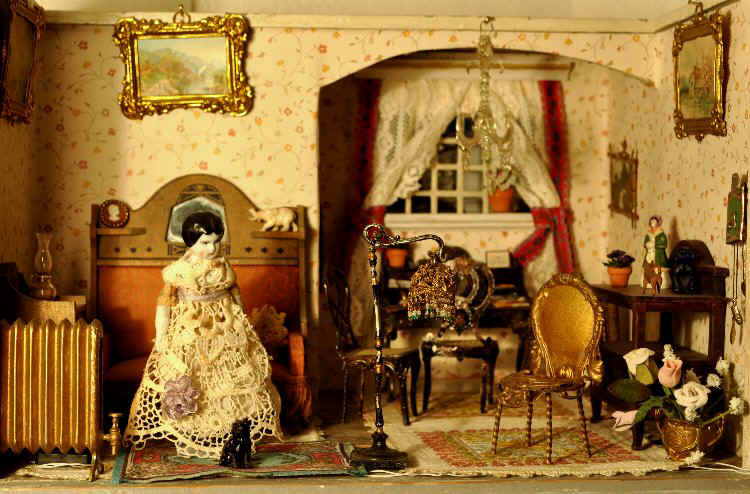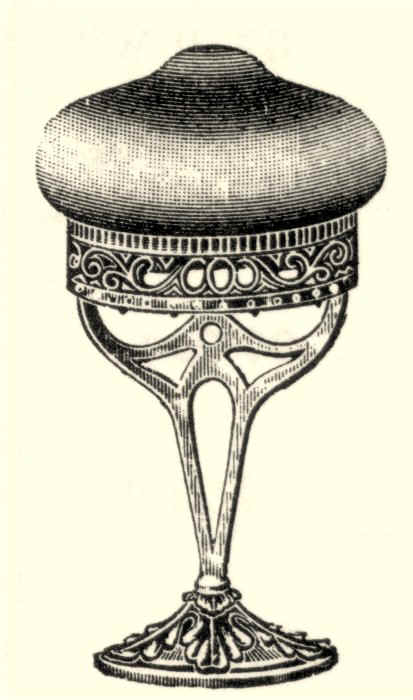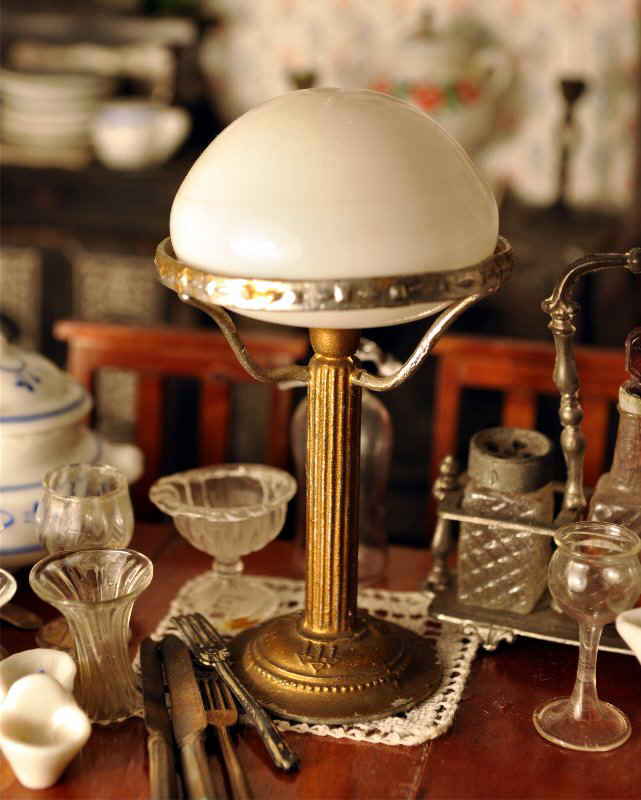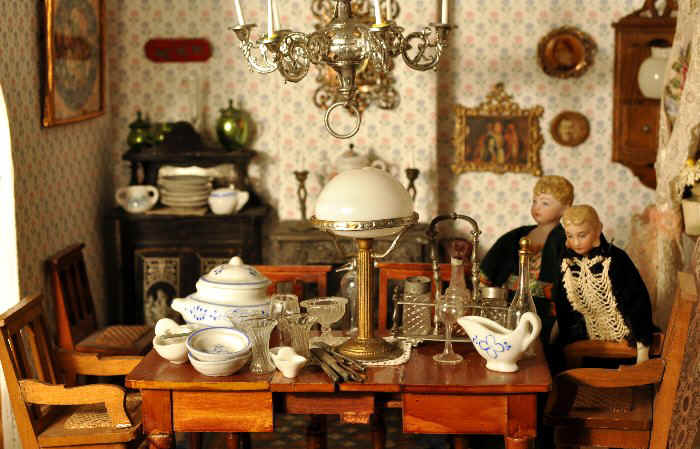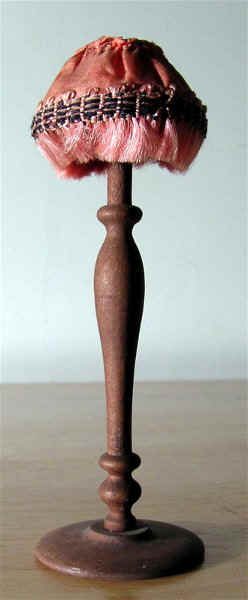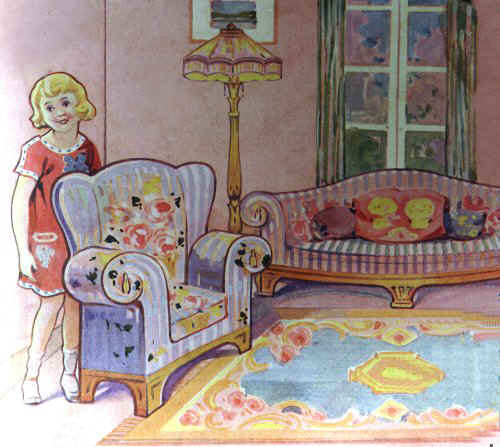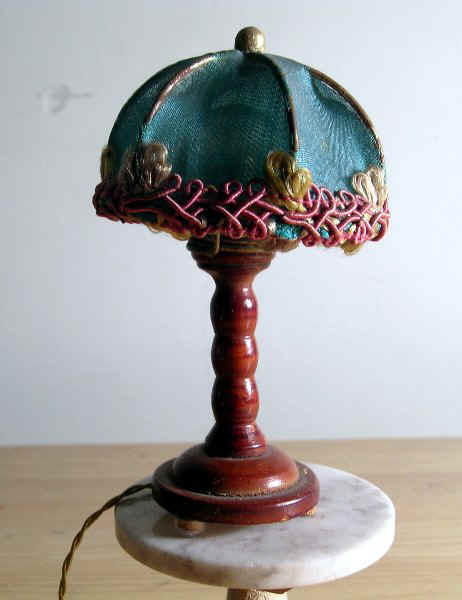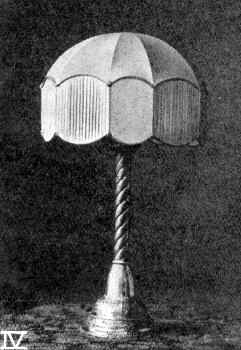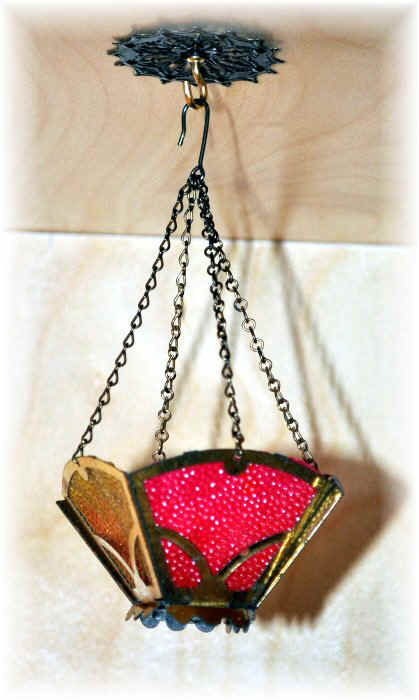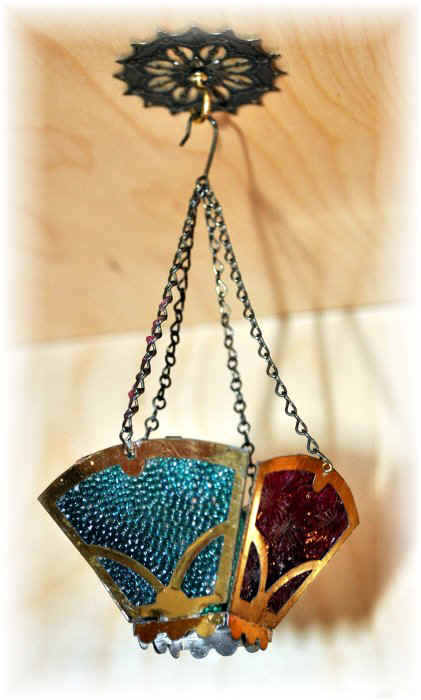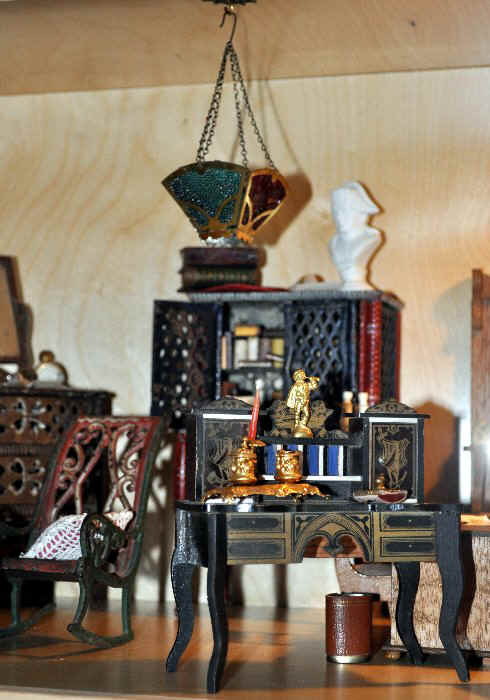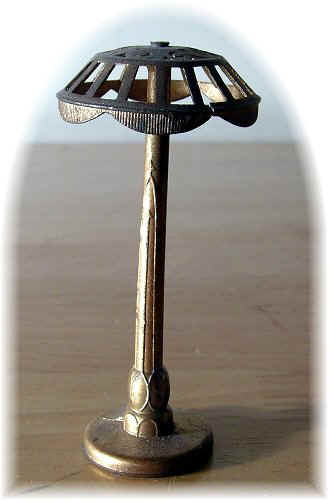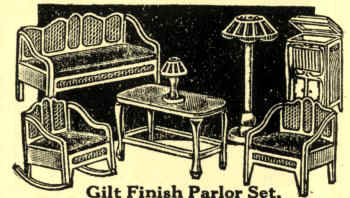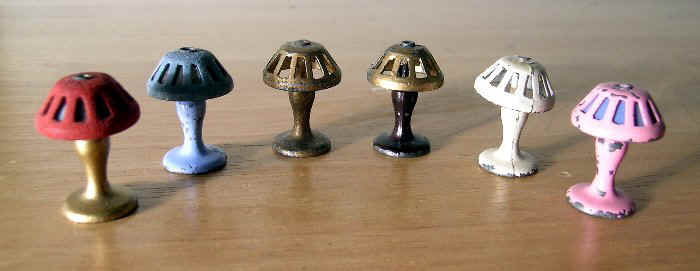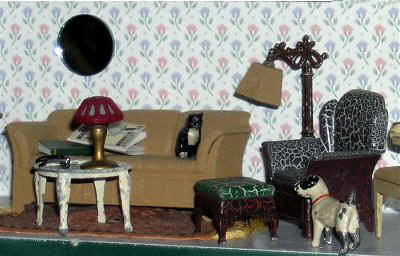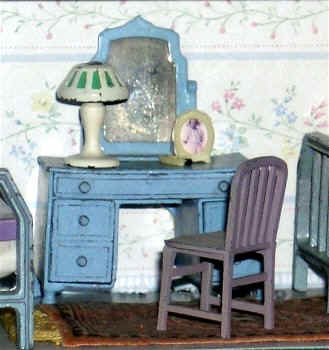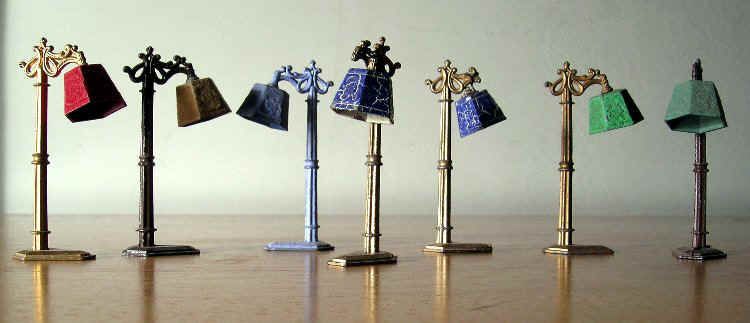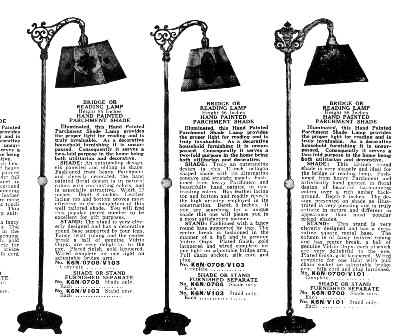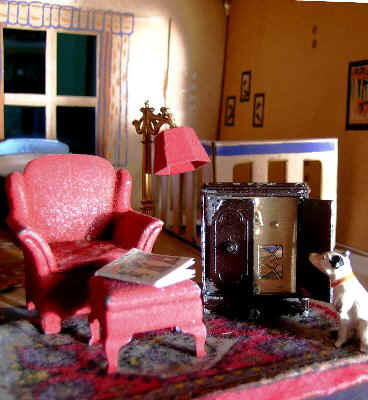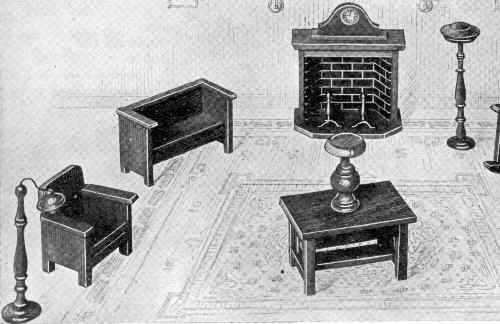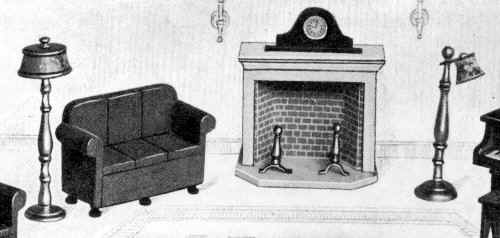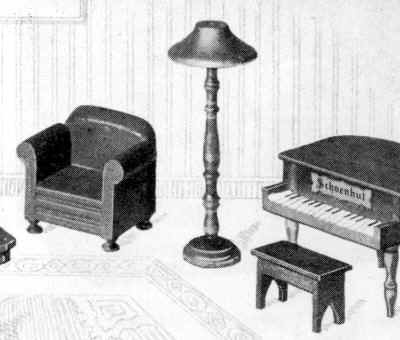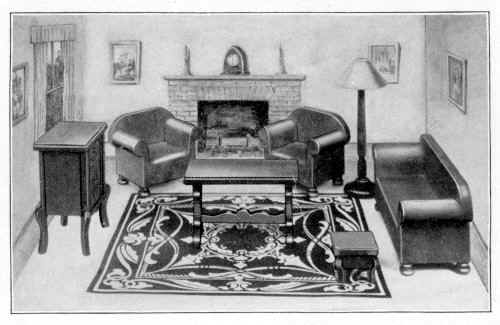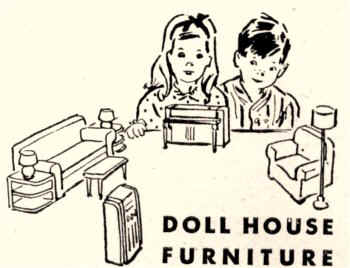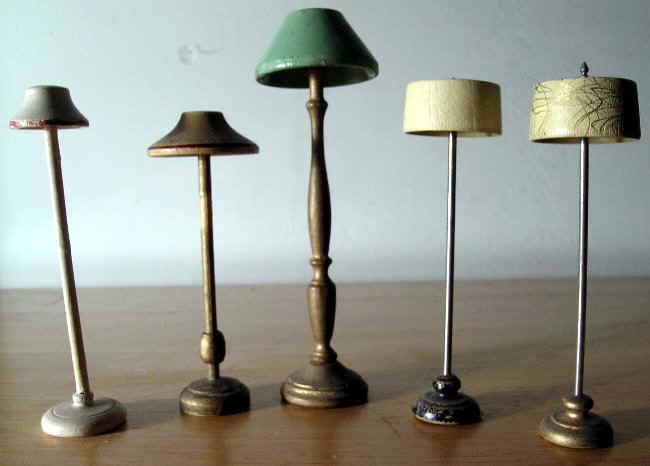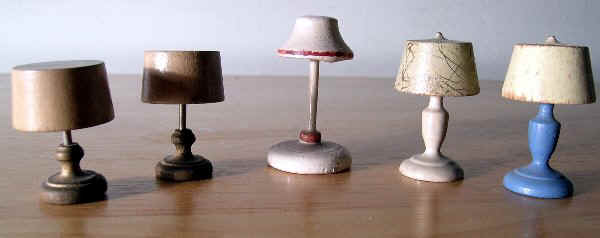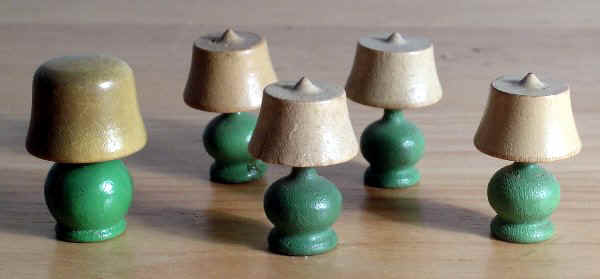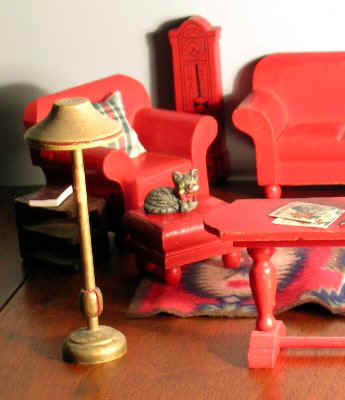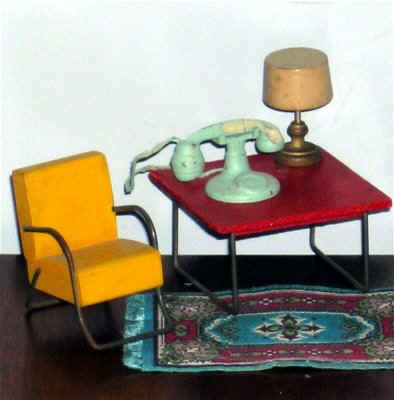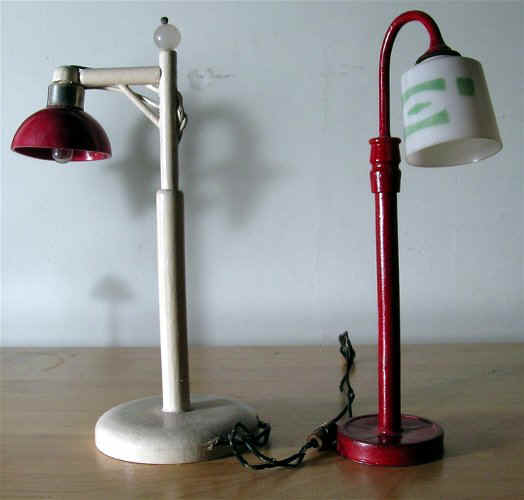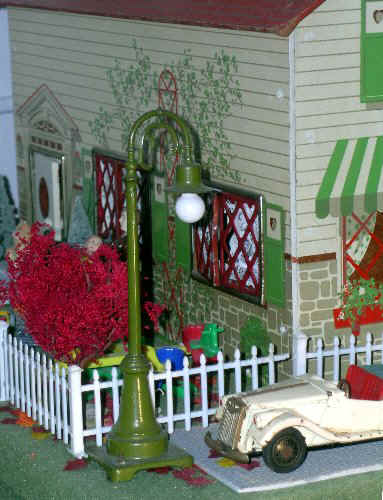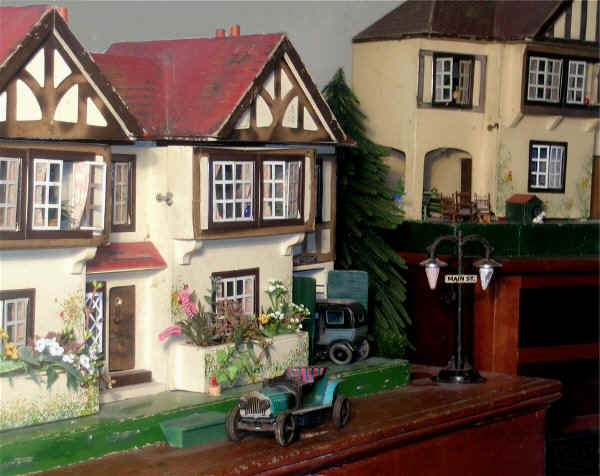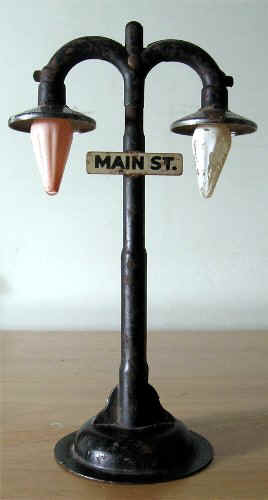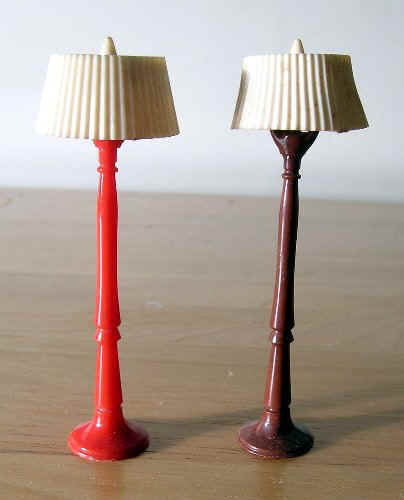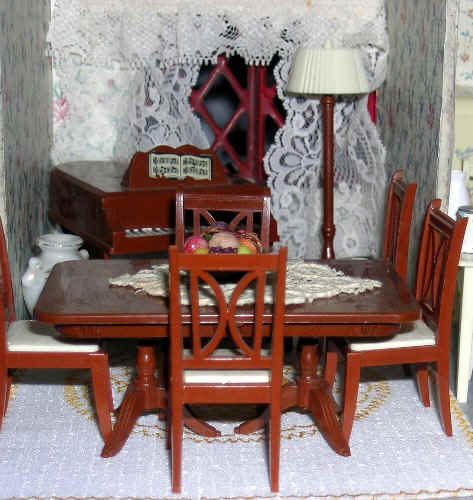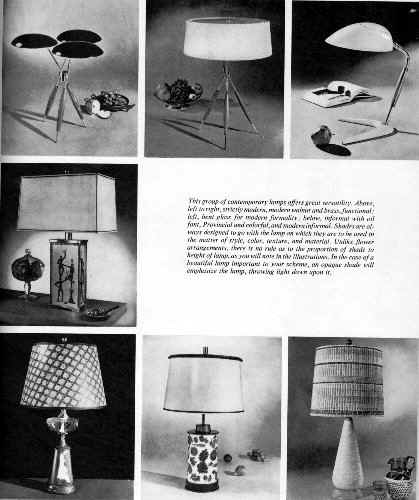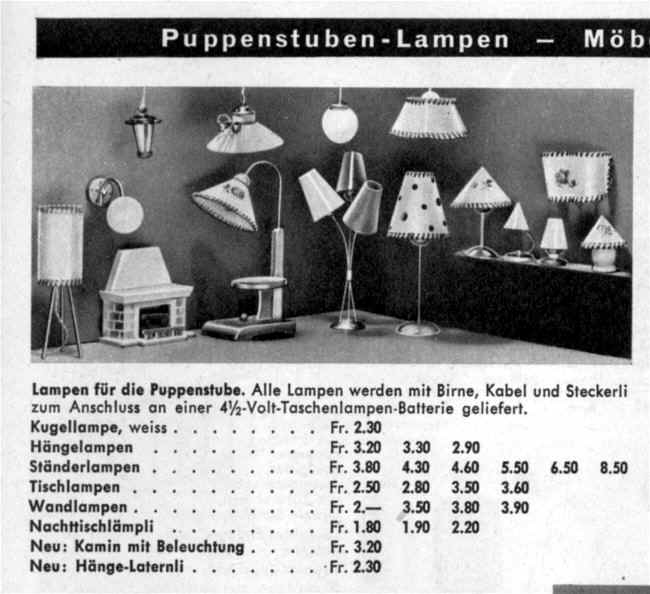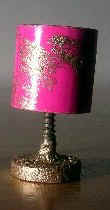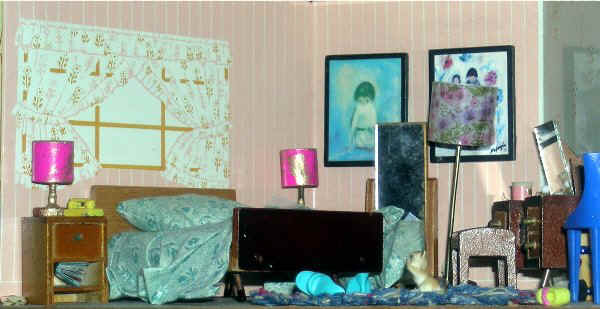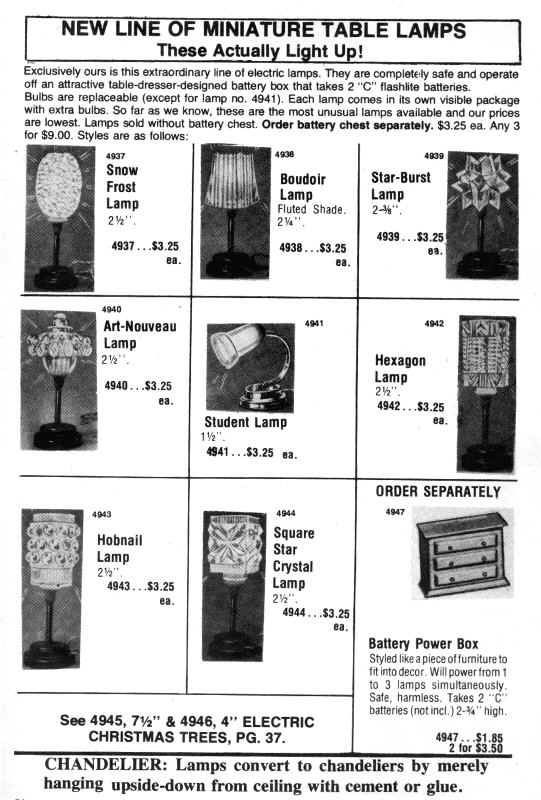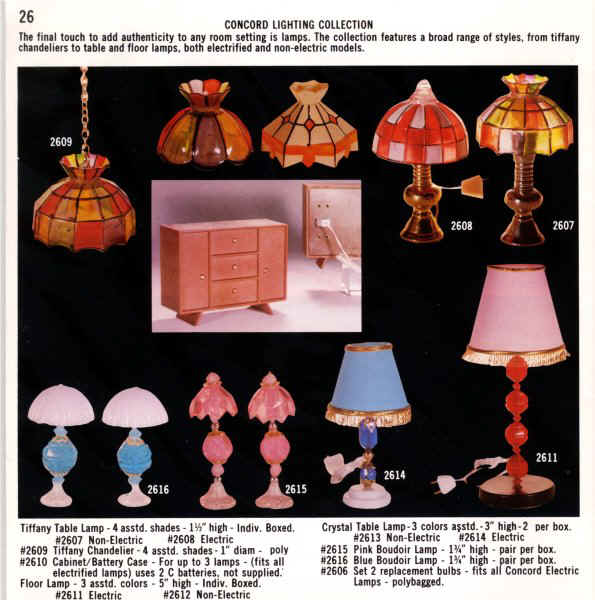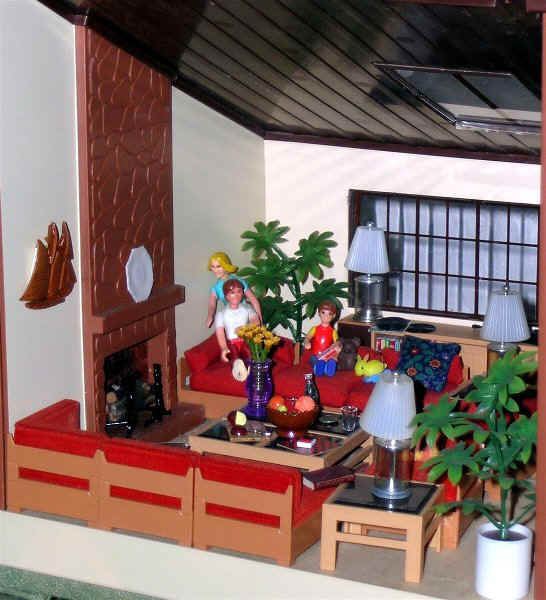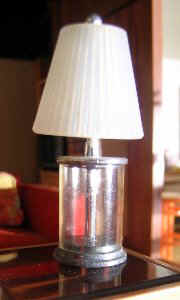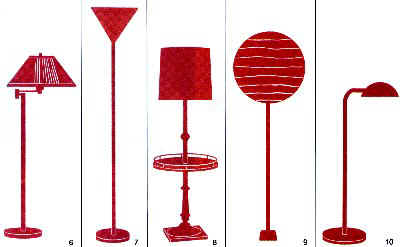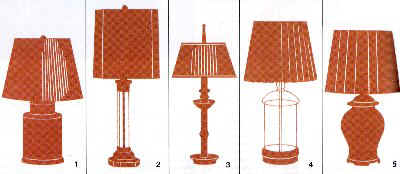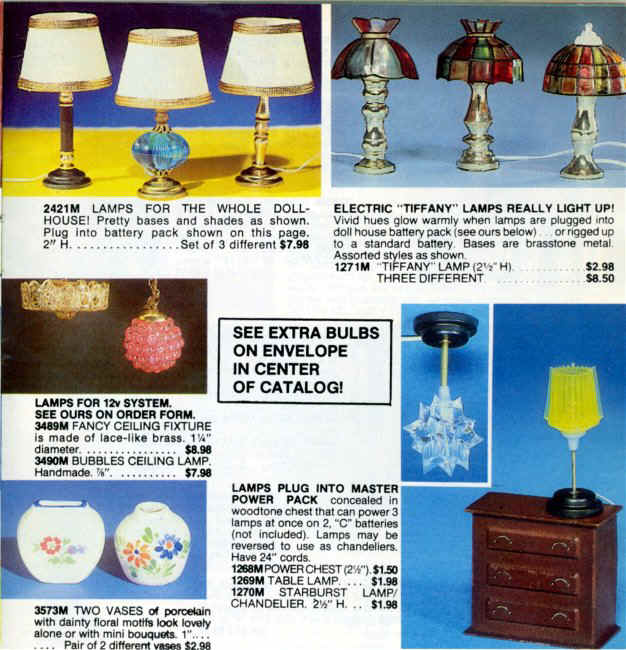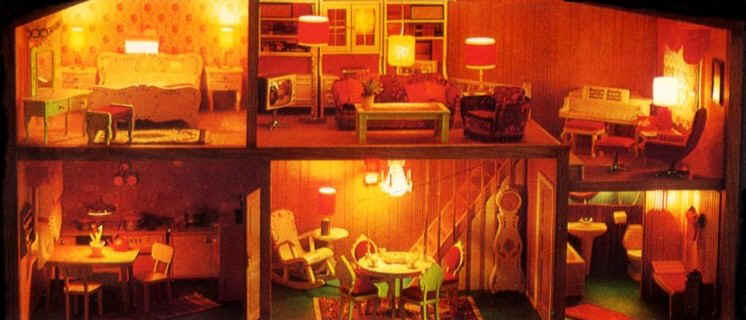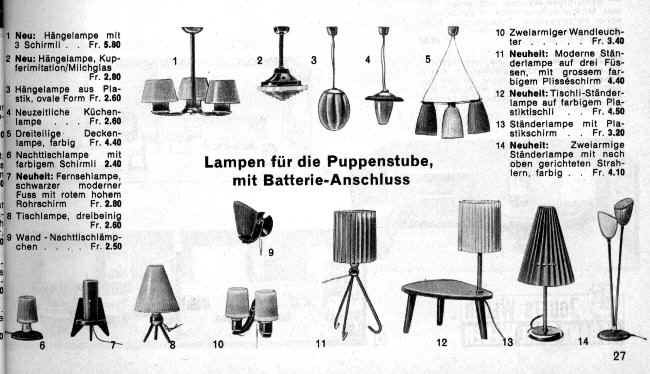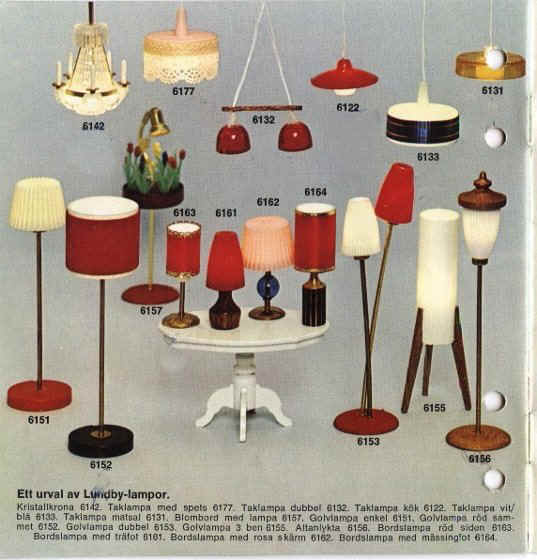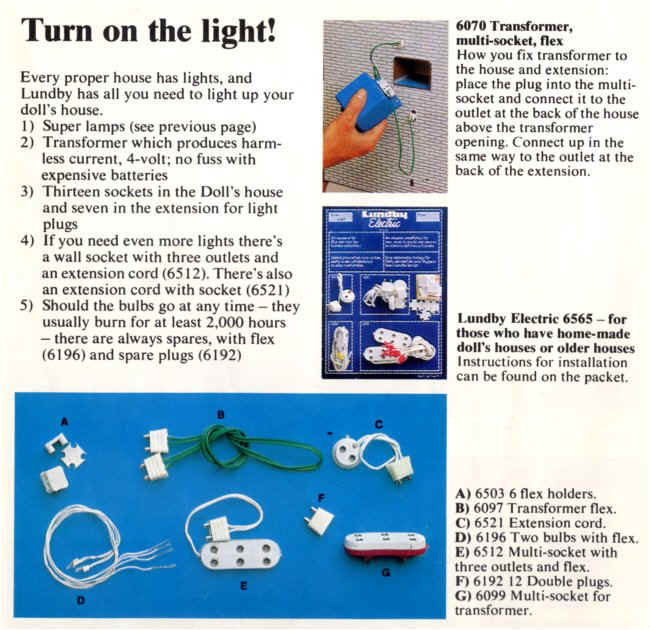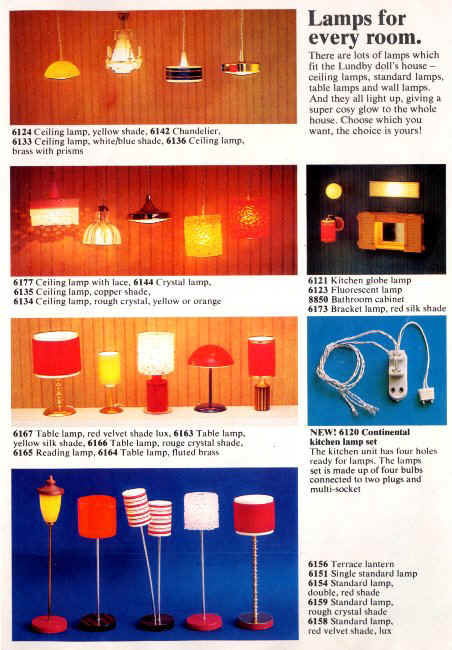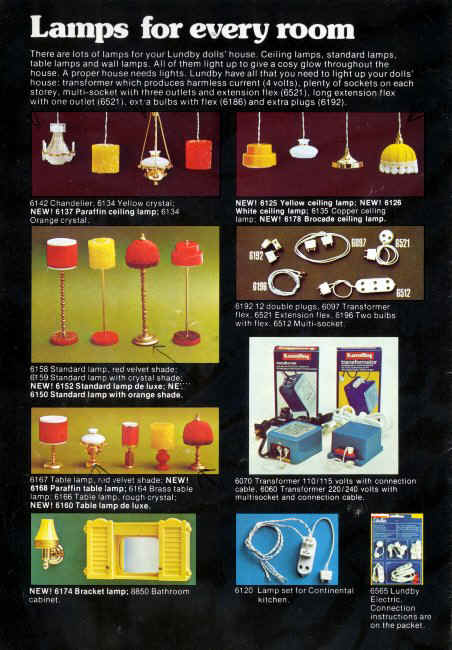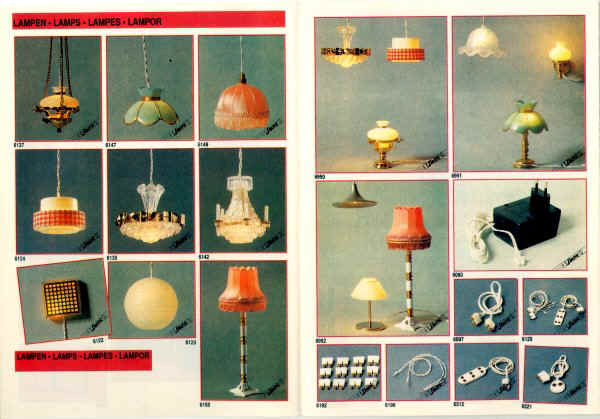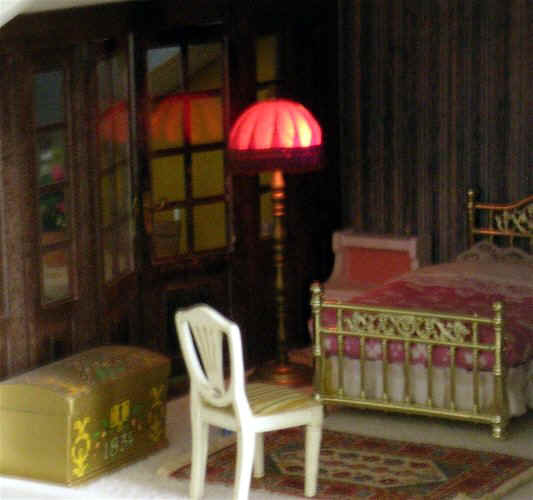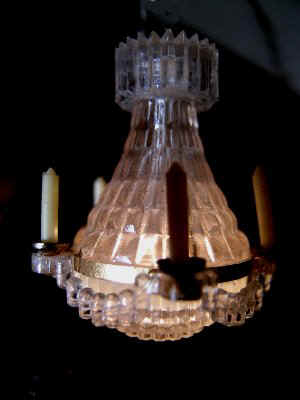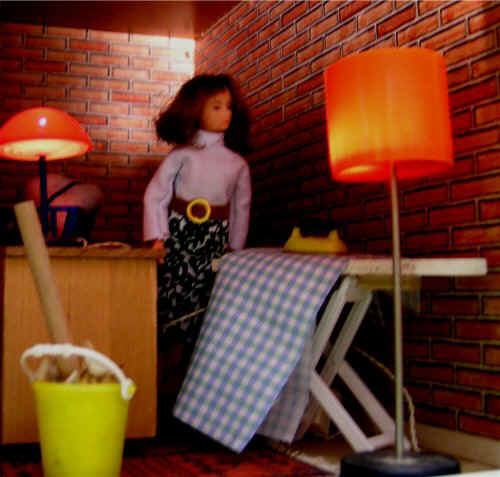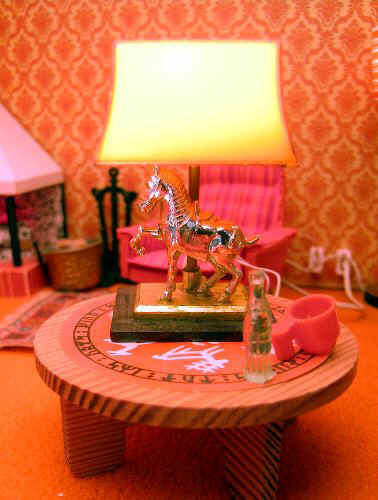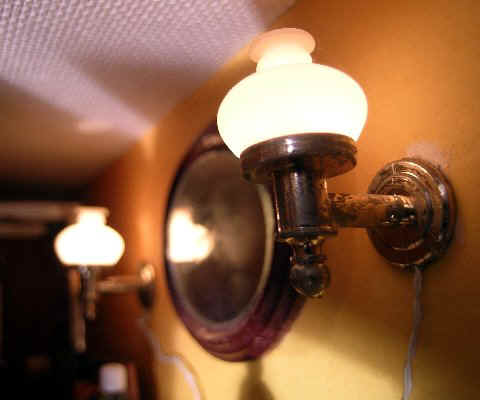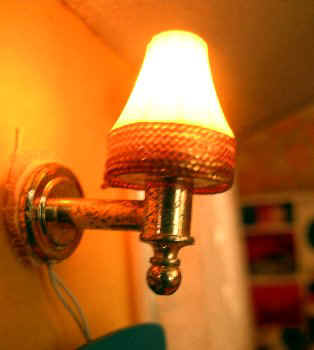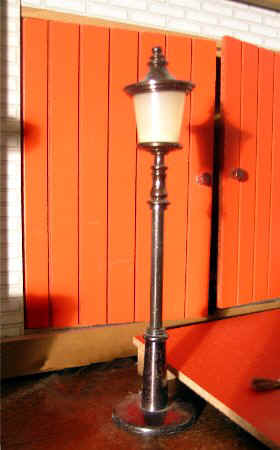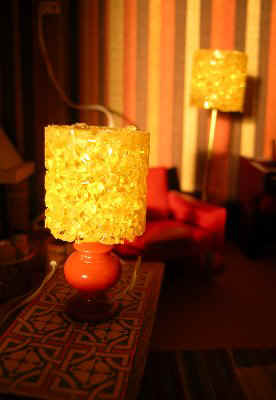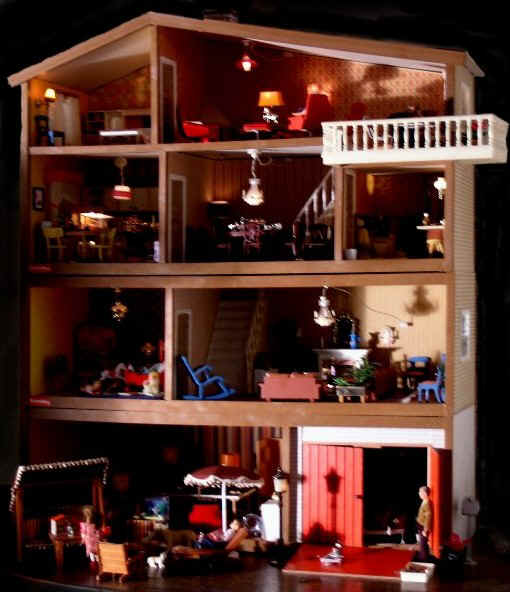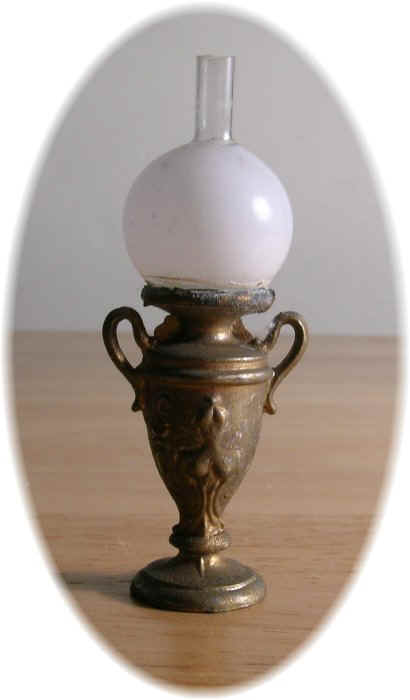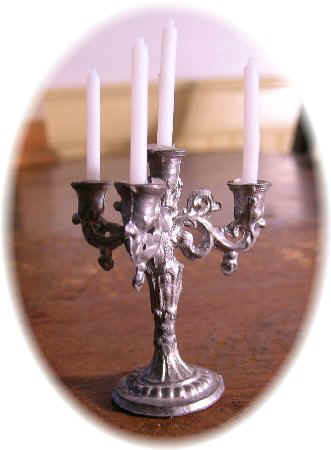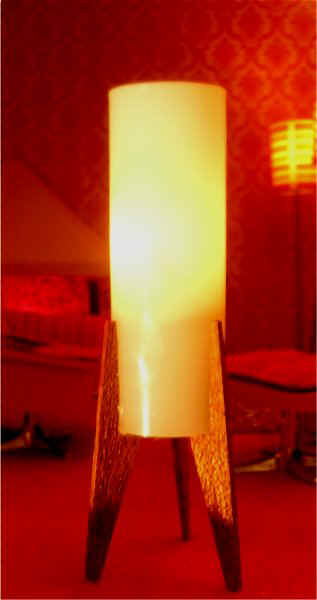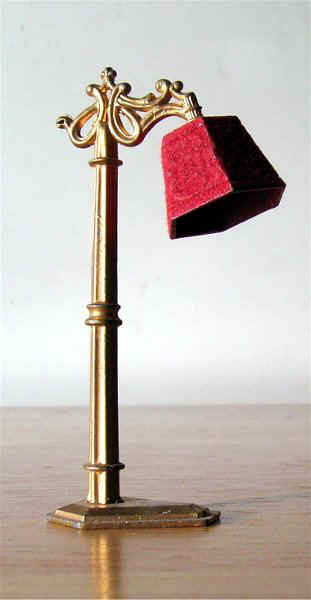|
selected examples of gas and electric light fixtures for dollhouses, 1890-1990 by Jennifer McKendry photography by Jennifer McKendry© home page return to beginning of lights for dollhouses (candles) Gas lighting was available for those
areas serviced by gas lines at the same time as electricity during the period under study
(1890 on) but, as it was available much earlier (as early as c1800 in France and England)
than electricity, it was the conventional form of lighting for the middle and upper
classes in the late 19th and early 20th centuries. In Kingston, Ontario, Canada (a
medium-sized city on the north shore of Lake Ontario), for example, gas was produced from
Real electric fixtures, 1901-02, with shades and bulbs
right Dollhouse white shade and clear-glass electric bulb (both made of glass in one unit), German, early 20th century
above Dollhouse wall scounce holding an electric "bulb" with point at the top and a white scalloped shade, German, early 20th century
(note: "real" in the following means actual, functioning, "real life" items, not miniatures)
top left Real gas chandeliers in the Sear Roebuck catalogue 1908 bottom left Real gas chandelier hanging in a Kingston house; note pulley and weights to raise and lower the fixture; has been electrified in recent years top right Dollhouse Märklin metal and glass gas chandelier with 6 arms, Germany, late 19th - early 20th centuries; note the wide openings of the shades
Although this metal 4-arm chandelier is meant for gas (note the lack of fonts acting as reservoirs for kerosene), the original white glass shades have a relatively small top openings and separate clear-glass chimneys, reminding one of the arrangements for an oil lamp; on the other hand, the chimneys are so narrow that they would not function well to draw the flame from the wick; they do, however, help to hold the shades in place and that may be their true function; German, late 19th - early 20th centuries
Dollhouse metal gas chandelier with replacement globes and chain, 4 arms with a detail showing the complexity of the form created from vines, hanging flowers and scrolls, German, late 19th - early 20th centuries
Forever flying down to the lights, this naked cherub is oddly positioned on this metal chandelier and why is he there at all? This is an interesting fixture, as the downward 3 arms had to be for electric bulbs (which are early ones but not original to the lamp), while the alternating 3 upward turned arms suggests gas (replacement shades) but, in that case, the main central post would have to accomodate wiring and gas lines, which would then feed into the appropriate arms; in an era of uncertain electrical power, one can imagine the desire for the more reliable gas supply as a back up; perhaps all the arms were for electric bulbs; if this fixture appeared in a surviving period catalogue, the answer about the power source or sources may be provided; German, early 20th century
Erhard & Söhne dollhouse lighting fixtures for candles, gas, electricity and oil, German, early 20th century note: For readers interested in products made by the Erhard & Söhne Company, see Swantje Köhler, Ormolu Dollhouse Accessories, Metal Toys from the Erhard & Söhne Company, 2007.
below & right dollhouse electric lighting fixtures in a Märklin, Germany, catalogue of 1909 but likely manufactured by Erhard & Söhne (see Swantje Köhler's 2007 book on the latter company, pp. 5-6)
note fixture in upper left corner, as a comparison with the one below
two-branch, ormolu, table light fixture with an upright third holder for electric bulbs (original) by Erhard & Söhne ; the example in the company's c1905 catalogue is a transitional lamp with downward facing electric bulbs and an upright gas shade note: For readers interested in products made by the Erhard & Söhne Company, see Swantje Köhler, Ormolu Dollhouse Accessories, Metal Toys from the Erhard & Söhne Company, 2007.
the Rococo Revival light fixture, 3¼ inches high, has its original wiring with a brass switch showing at the edge of a carpet hiding the cardboard backing for the wires; the bulb (below) has a hole for the wire connections, which can still be seen on the matching bulb
top and reverse of the card holding the wiring for the Erhard & Söhne light fixture, 5 x 6 inches, stamped "Germany"
Märklin dollhouse electric lighting fixtures, German, 1919; with cords and plugs; ornamented with long beaded fringes imitating cut glass drops, particularly popular in the 1920s
left Real ceiling electric fixture with coloured glass drops and a ball from the 1920s
right Dollhouse wall fixture with original light bulb, metal with fringe of white and green beads, German, 1920s; with wire attached so that it would actually light, probably with a battery as the power source; 1¾ inches long below left real floor lamp, tinsel lace top, georgette panels, tinsel flower trimming with heavy braid and 5-inch fringe, metal stand, 1920s below right dollhouse floor lamp with wire metal shade and beaded fringe "married" to a metal stand, 4 inches tall
left electric dollhouse lamp from Der Universal-Spielwaren-Katalog of 1924-26 right white shade "married" to metal base, 1920s, 3 inches high
Living room in 1921-23 showing a floor lamp with a fabric shade decorated with a fringe. Dollhouse floor lamp on turned wood post with silk shade decorated by fabric trim and fringe, 1920s in style, label: "....maker, Philadelphia" , 4¾ inches high
above Real electric table lamp, 1924, The Studio Year-Book of Decorative Art Dollhouse electric table lamp with wiring, turned wood pedestal, silk shade on metal frame with fabric edging, likely German, 1920s
pair of collapsible hanging lights, metal frames, coloured and textured celluloid, original chains and hooks (ceiling medallions are new), may have been made as ornaments to hang on a Christmas tree, German, 1920s
Miniature parlour floor lamp, painted metal, the filigree shade may be an imitation of real shades formed by decorative cast metal; made by Tootsietoy, USA, advertised in 1923
Tootsietoy table lamps in various colours, some with contrasting inserts in the shades, 1 inch high, 1920s-'30s
Tootsietoy made what were likely the nicest dollhouse lamps in the United States during the 1920s and '30s; the forms were limited in number but different colours and combinations of colour made them seem more varied; the colours co-ordinated with their small-scaled, painted, metal furniture; the floor lamps are 2¾ inches high, and closely resemble real lamps of the era (above left)
American manufacturers of wooden dollhouse furniture in the 1930s did not create the finely detailed work of Tootsietoy, largely because the latter were able to cast malleable metal into inexpensive pieces, which appeared realistic when painted. Schoenhut living room with table and floor lamps, painted wood, USA, 1928
Schoenhut living room with floor lamps, painted wood, USA, 1930
Schoenhut living room with a floor lamp, painted wood, USA, 1931
Realy Truly, living room floor lamp, wood, USA, 1931
The American firm Strombecker dominated the wooden dollhouse furniture market in North America in the 1940s; ad from December 1947 Children's Activities showing a floor lamp and pair of table lamps
above & below Typical wooden dollhouse lamps of the 1930s, '40s and into the 1950s, many made by Strombecker, including the floor lamps with metal rods
Street lights, made for the appropriate scale of train sets, can work with dollhouses, 1930s, '40s & '50s
American plastics ruled after the second World War; they had the advantage of being easily moulded in various colours and permitting fine detailing at a small scale; important firms in the 1950s were Ideal, Renwal, Marx, Plasco and Allied; the Reliable Company produced dollhouse furniture in Canada but mainly used moulds provided by Ideal
Renwal floor lamps with "pleated" shades
Modern design began to infiltrate middle class furnishings in the 1950s with geometric abstract shapes, new materials like chrome, and clean lines rejecting historicism; on the other hand, tradition survived in classical and revival designs as seen in the electric "oil lamp" in the bottom left corner of this illustration of real lamps from the 1954 Ladies Home Journal printed in Philadelphia
Germany had been a hot bed of modern design previous to the outbreak of World War Two; some of these dollhouse lamps of 1960 in Franz Carl Weber's toy catalogue reflect futuristic forms
The hot pop colours of the 1960s; possibly home-made table lamps
Table lamps operating on two C batteries hidden in a special dollhouse dresser; the table lamps became chandeliers by hanging them upsidedown and gluing the "bases" to the dollhouse ceiling; Federal Smallwares catalogue, New York, 1975; they distributed Shackman items, imported from the East
Typical dollhouse plastic lamps from the 1970s; some show the revived interest in Tiffany stained glass lamps; Concord catalogue, 1978
Tomy selected an attractive table lamp to feature in its 1980s line; the pleated shade and clear body reflect a contemporary style, as seen in the profiles (#4) below; plastic not wired
Fashionable real lamps of the 1970s & '80s, Better Homes & Gardens, USA, 1981 (compare #4 with the Tomy lamp above)
Popular dollhouse lamps of the 1980s from conventional to Tiffany revival to what looks like something from outer space, Lynne's Dollhouse Treasures, 1982
We can give the last word on electric lights to Lundby of Sweden, as the company took particular pride in their realistic, wired lights, which plugged into wiring hidden behind wallpaper on the back walls; the wires ran to a transformer connected to real household power (instead of a system using lamps plugged into batteries). Certain dollhouse lights had been wired since at least 1919, as we saw in the Märklin catalogue. The range of Lundby lights runs the gauntlet from very traditional to very modern, and many were made over many years before being dropped from the line. Some models incorporated real fabric in the shades in an era dominated by plastic. By 1974, there were over the counter lights in the kitchen, as well as a light in the oven. above The image of the Gothenburg house in full lit splendour appeared in the 1974 Lundby catalogue.
Lamps from 1963-64 (Weber's toy catalogue), including some very modern forms such as #7, similar to one (below) in the 1970 Lundby catalogue
1970 Lundby catalogue; note the lamp illuminating flowers on a stand (#6157)
1974 Lundby catalogue
1974 Lundby catalogue
1976 Lundby catalogue
1990 Lundby catalogue
this ends the story of dollhouse lights
top of page home page t return to beginning of lights for dollhouses (candles) history of dollhouses GALLERY of IMAGES of dollhouses & furnishings dolls for dollhouses 1 dollhouse references on dollhouses & miniatures
|
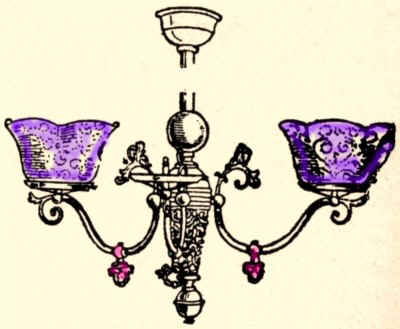 burning coal by a company founded in 1850 and electricity was
introduced in 1888. In the 1897 Sears Roebuck Company catalogue, USA, no electric lights
were shown. In the Eaton's, Toronto, mail-order catalogue of 1901-02, "[oil] Lamp,
Gas and Electric Fixtures" were offered, including "combination fixtures".
The new electric lights were modelled after the established gas fixtures with certain
forms (but not the working parts) interchangeable. This metal and glass chandelier (right)
could be purchased set up for gas or electricity: the 2-arm model sold for $6
for gas, $5 for electric but not wired or $5.75 if wired. Presumably the stopcocks on the
arms -- necessary for gas (shown in pink on the image on the right) -- were not used on
the electrified model. Shades or globes (shown in purple) were not essential for either
gas or electricity but usually present to soften and diffuse the light
burning coal by a company founded in 1850 and electricity was
introduced in 1888. In the 1897 Sears Roebuck Company catalogue, USA, no electric lights
were shown. In the Eaton's, Toronto, mail-order catalogue of 1901-02, "[oil] Lamp,
Gas and Electric Fixtures" were offered, including "combination fixtures".
The new electric lights were modelled after the established gas fixtures with certain
forms (but not the working parts) interchangeable. This metal and glass chandelier (right)
could be purchased set up for gas or electricity: the 2-arm model sold for $6
for gas, $5 for electric but not wired or $5.75 if wired. Presumably the stopcocks on the
arms -- necessary for gas (shown in pink on the image on the right) -- were not used on
the electrified model. Shades or globes (shown in purple) were not essential for either
gas or electricity but usually present to soften and diffuse the light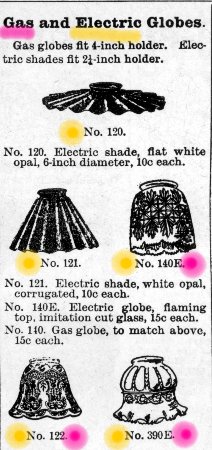 . Certain forms were interchangeable for either source of power and
typically wide open at the top (pink for gas and yellow for electric at left). The gas
ones tended to be bell or tulip shaped,
. Certain forms were interchangeable for either source of power and
typically wide open at the top (pink for gas and yellow for electric at left). The gas
ones tended to be bell or tulip shaped,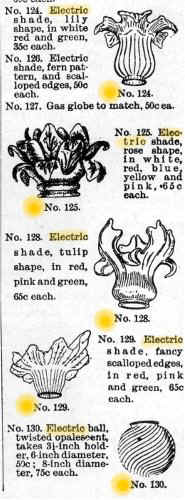 perhaps scalloped at the rim, and were positioned facing
upwards to allow the flame to work from the jet of gas. The electric ones (in yellow) were
more flexible in shape, including flat and pleated, floral and globe-like, and could be
positioned in any direction. The early electric bulbs were very large with a point on the
rounded end. This means they stick out beyond the shades.
perhaps scalloped at the rim, and were positioned facing
upwards to allow the flame to work from the jet of gas. The electric ones (in yellow) were
more flexible in shape, including flat and pleated, floral and globe-like, and could be
positioned in any direction. The early electric bulbs were very large with a point on the
rounded end. This means they stick out beyond the shades.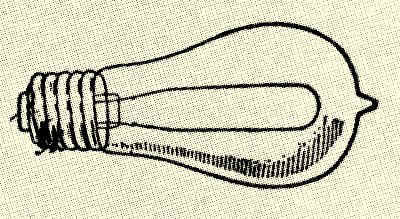

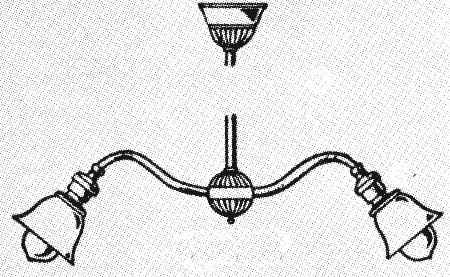

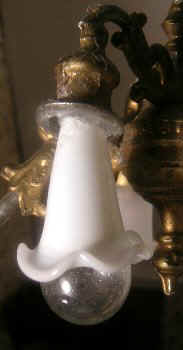 left Newel post fixture, 26 inches high, shown in the 1901-02
Eaton's catalogue with an electric bulb in place but also available as a gas fixture
left Newel post fixture, 26 inches high, shown in the 1901-02
Eaton's catalogue with an electric bulb in place but also available as a gas fixture